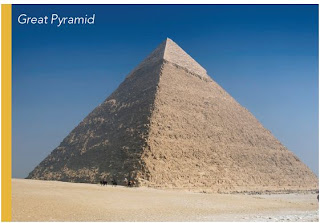In egypt pyramids are made of different types which suites to the condition at that particular time period.Mainly "pyramid at giza","step pyramid","bent pyramid" are all made with a particular goal.Here are some fabulous pics of varieties of pyramids-"THE MAIN ATTRACTIONS OF EGYPT " which makes egypt one of the best tourist place in the whole world.

The Great Pyramid Of Giza
The Great Pyramid of Giza (also known as the Pyramid
of Khufu or the Pyramid of Cheops)
is the oldest and largest of the three Pyramids in the Giza
Necropolis bordering what is now El Giza, Egypt. It is the oldest of the Seven
Wonders of the Ancient World, and the only one to
remain largely intact. Egyptologists believe that the pyramid was built as a tomb for fourth dynasty Egyptian Pharaoh Khufu(Cheops in Greek) over a 10 to 20-year period concluding
around 2560 BCE. Initially at 146.5 metres (481 feet), the Great Pyramid
was the tallest man-made structure in the world for over 3,800 years. Originally, the Great
Pyramid was covered by casing stones that formed a smooth outer surface; what
is seen today is the underlying core structure. Some of the casing stones that
once covered the structure can still be seen around the base. There have been
varying scientific and alternative theories about the Great Pyramid's
construction techniques. Most accepted construction hypotheses are based on the
idea that it was built by moving huge stones from a quarry and dragging and
lifting them into place.
The great pyramid is located just outside of cairo.It was built by one of the earliest kings of egypt who intendit to be the tomb,or burial place for himself.
THE BENT PYRAMID AT DASHUR
The bent pyramid is located
at the south of saqqara.
The Bent Pyramids of dashur is unique for 2 reasons.The first is the angle change .There are two theories for this change .The first that the builders may ave gotten tired and wanted to reduce the volume and to finish faster.Another is that when the pyramid at the meidoem collapsed ,the architecture lost his nerve and changed the angle.
The second reason is that the bent pyramid of dashur has two entrances .
The Bent Pyramids of dashur is unique for 2 reasons.The first is the angle change .There are two theories for this change .The first that the builders may ave gotten tired and wanted to reduce the volume and to finish faster.Another is that when the pyramid at the meidoem collapsed ,the architecture lost his nerve and changed the angle.
The second reason is that the bent pyramid of dashur has two entrances .
THE STEP PYRAMID OF SAQQARA
The step pyramid of Saqqara , also known as Pyramid of Djoser,
was built in 2630 BC by Imhotep. The Step pyramid of Saqqara was made for the
pharaoh, Djoser and began as a normal mastaba, but was subsequently enlarged by
adding one mastaba on top of another until it consisted of six terraces
reaching about 60 meters high. The surface of the Pyramid of Djoser was
originally encased in smooth white limestone.
THE RED PYRAMID OF DASHUR
The Red Pyramid of Dahshur is given its name because of the red stone used to build it,
although, originally, the red Pyramid of Dahshur was covered in a white casing
which has all gone now. The red Pyramid of Dahshur was built by the pharaoh
Snefru and took about 17 years to build. The Red Pyramid of Dahshur is actually
the third largest Pyramid in Egypt, and is very close to the Bent Pyramid.
SPHINX
Situated
on the Giza plateau with the great pyramids, the Sphinx,
with the head of a man, a body of a lion, is there to protect the pyramids. The
Sphinx is now under major restoration after centuries of erosion by sand wind
and rain, even Napoleon had his share when his troops used it for target
practice during their occupation of Egypt, and hence they blew the nose off. The statue of the
great sphinx is said to have the head of the pharaoh Kahfre

BEAUTIFUL SMALL PYRAMIDS IN EGYPT
OTHER ANCIENT CONSTRUCTIONS FOUND IN SAQQARA AND DASHUR
XXXXXXXXXXXXXXXXXXXXXXXXXX











































